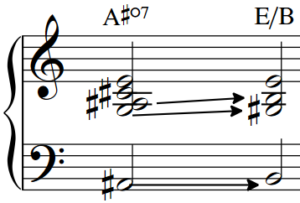Your Smiling Face - Piano Tutorial

In this article we're going to investigate a classic James Taylor tune, "Your Smiling Face." This is a great tune to learn for a number of reasons. First it has some great, challenging, and dense chords and voicings. Second, it's a tune that works in a full band setting or solo piano. Thirdly, people recognize it and love it. And fourthly it's a great example of some music theory concepts that can really help us understand diatonic chords and diminished passing chords. And of course, you should definitely check out our full lesson of "Your Smiling Face" complete with all of the details to help you master this tune at the piano.
Your Smiling Face - The Verse Chords
Let's check out the first four bars of the verse to "Your Smiling Face."
Notice that the bass line is simply walking down an E major scale. Starting on the E, the bass line descends D#, C#, B, A, G#, F#, and then up to the B. Also notice that all of the chords are diatonic chords, although many of the chords are what we refer to as slash chords. Understanding slash chords is quite easy - you simply play the chord to the left of the slash, and in the bass you play the note to the right of the slash.
Next let's do a quick harmonic analysis which will allow us to transpose the chord progression to another key.
E (I), B/D# (V), C#m (vi), E/B (I), A (IV), E/G# (I), F#m (ii), B7sus (V7sus)
Let's use the harmonic analysis above to transpose the chords to the key of F.
Here is the progression - I, V, vi, I, IV, I, ii, V7sus. Remember that the bass line (left hand) will simply walk down an F major scale. The right hand chords will be F, C/E, Dm, F/C, Bb, F/A, Gm, C7sus.
Your Smiling Face - The Pre-Chorus Chords
In the prechorus things get pretty interesting as we encounter a couple diminished passing chords. Let's take a look at the first 4 measures.
Many of the chords in the four measures above are diatonic chords. But let's look at the two diminished chords. The first is the A#dim7 chord moving to the E/B chord. This is a very common gospel-style progression that is often used to help move from the IV chord (the A major chord in measure 2) to the E/B chord in measure 3. The diminished chord helps create a chromatic movement in the bass (moving up in half-steps, A, A#, B). Also, the notes of the A#dim7 chord resolve by half-step (strong resolution) to the E/B chord.
Now check out the Cdim7 chord in measure 3. The notes of the Cdim7 chord are F#, A, C, and Eb. These notes function as the 7th, flat 9th, 3rd, and 5th of an Ab7 chord. Why an Ab7 chord? Because Ab7 (or G#7) functions as the 'V7' chord leading to its 'i' chord, C# minor. This is a very common function of diminished chords in rock and jazz. So whenever you see diminished chords, consider that they could be "dominant 7 flat 9" chords resolving to their "I" chord.


